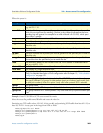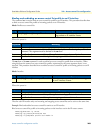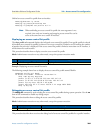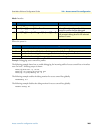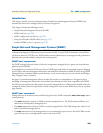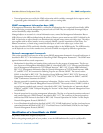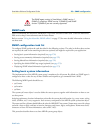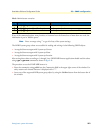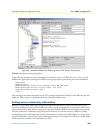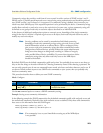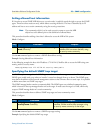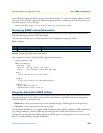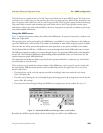
Identification of a SmartNode via SNMP 269
SmartWare Software Configuration Guide 25 • SNMP configuration
• Traversal operations are used by the NMS to determine which variables a managed device supports and to
sequentially gather information in variable tables, such as a routing table.
SNMP management information base (MIB)
A Management Information Base (MIB) is a collection of information that is organized hierarchically. MIBs
are accessed using a network-management protocol such as SNMP. They are comprised of managed objects
and are identified by object identifiers.
Managed objects are accessed via a virtual information store, termed the Management Information Base or
MIB. Objects in the MIB are defined using the subset of abstract syntax notation one (ASN.1) defined in the
SMI. In particular, an object identifier, an administratively assigned name, names each object type. The object
type together with an object instance serves to uniquely identify a specific instantiation of the object. For
human convenience, a textual string, termed the descriptor, to refer to the object type, is often used.
An object identifier (OID) world-wide identifies a managed object in the MIB hierarchy. The MIB hierarchy
can be depicted as a tree with a nameless root, the levels of which are assigned by different organizations.
Network management framework
This section provides a brief overview of the current SNMP management framework. An overall architecture is
described in RFC 2571 “An Architecture for Describing SNMP Management Frameworks”. The SNMP man-
agement framework has several components:
• Mechanisms for describing and naming objects and events for the purpose of management. The first ver-
sion, Structure of Management Information (SMIv1) is described in RFC 1155 “Structure and Identifica-
tion of Management Information for TCP/IP-based Internets”, RFC 1212 “Concise MIB Definitions”,
RFC 1213 “Management Information Base for Network Management of TCP/IP-based Internets: MIB-
II”, and RFC 1215 “A Convention for Defining Traps for use with the SNMP”. The second version,
SMIv2, is described in RFC 2233 “The Interfaces Group MIB using SMIv2”, RFC 2578 “Structure of
Management Information Version 2 (SMIv2)”, RFC 2579 “Textual Conventions for SMIv2”, and RFC
2580 “Conformance Statements for SMIv2”.
• Message protocols for transferring management information. The first version, SNMPv1, is described in
RFC 1157 “A Simple Network Management Protocol (SNMP).” The second version, SNMPv2, which is
not an Internet standards track protocol, is described in RFC 1901 “Introduction to Community-Based
SNMPv2” and RFC 1906 “Transport Mappings for Version 2 of the Simple Network Management Proto-
col (SNMPv2)”.
• Protocol operations for accessing management information. The first set of protocol operations and associ-
ated protocol data unit (PDU) formats is described in RFC 1157. The second set of protocol operations
and associated PDU formats is described in RFC 1905 “Protocol Operations for Version 2 of the Simple
Network Management Protocol (SNMPv2)”.
• A set of fundamental applications described in RFC 2573 “SNMP Applications” and the view-based access
control mechanism described in RFC 2575 “View-Based Access Control Model (VACM) for the Simple
Network Management Protocol (SNMP)”.
Identification of a SmartNode via SNMP
All product models have assigned sysObjectID.
Refer to the getting started guide of your product, or see the MIB definition file (.my) for sysObjectIDs.




